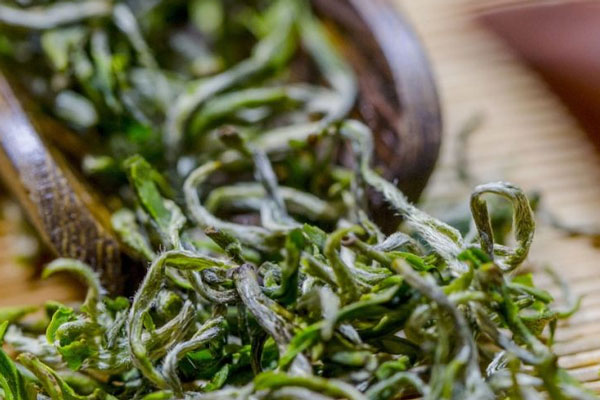Green tea has won the love of many tea lovers with its fresh taste. Its fresh taste is due to its different withering methods and drying processes. Let's learn about it together!

● Green Tea Processing Technology
Green tea is a non-fermented tea. Its production process mainly includes three steps: withering, rolling and drying
1. Fresh leaf spreading

Before processing green tea, the fresh tea leaves must be spread moderately. On the one hand, it makes them lose water and soften moderately, and also promotes the transformation of some contained substances. On the other hand, the low-boiling point green odor in the fresh leaves is volatilized, gradually emitting a fresh fragrance.
2. Killing the green tea

It is a key process in green tea processing. It destroys and inactivates the oxidase activity in the fresh leaves through high temperature, inhibits the enzymatic oxidation of tea polyphenols in the fresh leaves, evaporates part of the water in the fresh leaves, softens the tea leaves, and facilitates rolling and shaping. As the water evaporates, the aromatic substances with a grassy smell in the leaves evaporate and dissipate, enhancing the tea aroma. Killing the green tea is generally divided into pan-frying killing and steam killing.
3. Rolling

Rolling (or "shaping") is an important process for shaping the appearance of green tea. Through external force, the cells of the killed green leaves are properly broken, and the tea juice overflows from the vacuoles of the cells and adheres to the surface of the killed green leaves, making it easier for the contained substances to precipitate when brewing. At the same time, the tea leaves are shaped to form a unique tea appearance.
4. Drying

The drying methods include frying, drying, and sun drying.
The purpose of drying is to organize the strips on the basis of rolling and twisting, improve the appearance, give full play to the residual fragrance, fix the quality of tea, evaporate excess water at the same time, prevent mildew, and facilitate transportation and storage.
● Classification of green tea
The classification of green tea is mainly based on the different methods of killing and drying, which are divided into fried green tea, baked green tea, sun-dried green tea, and steamed green tea.
1. Fried green tea
Green tea is killed and dried by roller or pan frying. Its appearance is tight, the color is green and moist, the aroma is fresh, the soup color is green and bright, and the taste is rich and delicious.

During the drying process, fried green tea is subjected to different mechanical or manual forces, forming different shapes such as long strips, round beads, flat shapes, needles, and spirals, so it is divided into long fried green, round fried green, flat fried green, special fried green, etc. For example, West Lake Longjing is a typical flat fried green.

West Lake Longjing
2. Baked green tea
In the drying process, green tea is dried in a baking cage or drying machine. It has a complete appearance, dark green and oily color, elegant aroma, clear and bright soup color, and fresh and mellow taste.

It can be divided into two types: ordinary baked green and special baked green.
Ordinary baked green is called raw baked green after refining, and most of it is used as tea base for scenting various scented teas.
Special baked green is baked green famous tea, such as Huangshan Maofeng, Taiping Houkui, Anji white tea, Jingshan tea, etc.

Taiping Houkui
● Sun-dried green tea
Sun-dried green tea is green tea dried by sunlight. It has a rough appearance, dark green and oily color, strong aroma, bright yellow-green soup color, strong and mellow taste, and strong astringency.

It is mainly distributed in Hunan, Hubei, Guangdong, Guangxi, Sichuan, Yunnan, Guizhou and other provinces in China, and is produced in small quantities. Among them, the Yunnan large-leaf variety has the best quality, called "Dianqing", but most of them are used as raw materials for compressed tea.

Dianqing
● Steamed green tea
Steaming is an ancient Chinese method of killing green tea. It was introduced to Japan in the Tang Dynasty and has been used ever since. In my country, it has been changed to pan-frying since the Ming Dynasty.

Steaming green tea uses steam to destroy the enzyme activity in fresh leaves, forming the "three greens" quality characteristics of dark green color of dry tea, emerald green tea soup and green bottom of leaves, with a clear aroma and refreshing taste. Such as Enshi Yulu, Cactus Tea, Chinese Sencha, etc.

Enshi Yulu
Tips
The four categories of green tea do not exist separately. Many newly created famous green teas are mostly in the form of baking and frying. Generally, they are fried and shaped after killing green (or rolling), and then dried. This is a relatively reasonable processing mode in the processing of famous green teas, such as Yangyan Gouqing, Tiantai Yunwu, Yandang Maofeng, etc.

There are many varieties of green tea, and its world is like a treasure house. Every time you taste it, every time you explore it, you will have some new experiences. From the graceful posture of the tea leaves stretching in the cup, to the fresh taste lingering on the tip of the tongue, to the long-standing culture behind it, it is worth our careful tasting and feeling.

%20--%3e%3c!DOCTYPE%20svg%20PUBLIC%20'-//W3C//DTD%20SVG%201.1//EN'%20'http://www.w3.org/Graphics/SVG/1.1/DTD/svg11.dtd'%3e%3csvg%20version='1.1'%20id='图层_1'%20xmlns='http://www.w3.org/2000/svg'%20xmlns:xlink='http://www.w3.org/1999/xlink'%20x='0px'%20y='0px'%20width='256px'%20height='256px'%20viewBox='0%200%20256%20256'%20enable-background='new%200%200%20256%20256'%20xml:space='preserve'%3e%3cpath%20fill='%23FFFFFF'%20d='M194.597,24.009h35.292l-77.094,88.082l90.697,119.881h-71.021l-55.607-72.668L53.229,232.01H17.92%20l82.469-94.227L13.349,24.009h72.813l50.286,66.45l58.148-66.469V24.009z%20M182.217,210.889h19.566L75.538,44.014H54.583%20L182.217,210.889z'/%3e%3c/svg%3e)